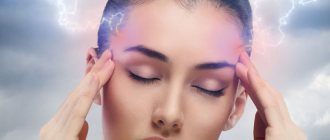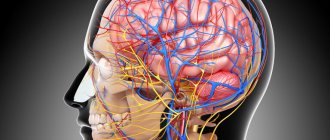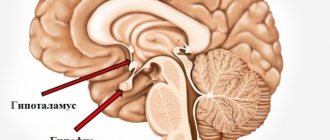Learn more about diseases starting with the letter “B”: Basilar impression, Basilar migraine, Beriberi, Bettolepsy, Amyotrophic lateral sclerosis, Alzheimer's disease, Wilson's disease, Hallerwarden-Spatz disease, Hamstorp disease, Hippel-Lindau disease, Canavan disease, Creutzfeldt disease -Jacoba, Lafora's disease, Machado-Joseph disease, Moya-moya disease, Morton's disease, Parkinson's disease, Pick's disease, Refsum's disease, Fahr's disease.
Migraine is classified into several different types of disease. One such type is basilar migraine. With this disease, various pathological changes occur in the basilar blood supply area.
Characteristic
Such a migraine is characterized directly by dizziness, ataxia, visual disturbances, hearing loss, sensory disorders, followed by an attack of headache.
This disease can be diagnosed by conducting studies such as X-rays of the brain, magnetic resonance or computed tomography of the brain, ultrasound or CT angiography of the vertebral arteries of the brain and spine, as well as by visiting a neurologist.
Pain and other disorders are relieved by inhalation of a mixture of carbon dioxide and oxygen. Prednisolone is also taken. Prevention against the disease is carried out directly in the interparoxysmal interval.
The basilar form of pathology is not as common as other types of this disease. The disease is classified as a particularly severe form, causing various complications. The blood supply to the brain is disrupted, which can lead to ischemic stroke.
Basilar migraine is distinguished by the absence of motor impairment, since similar basilar manifestations are present in familial hemiplegic migraine in most cases.
It has been noted that headaches mainly affect people aged 18 to 50 years; less often, this disease occurs in children and people whose age exceeds 50 years. In most cases, women are at risk. When diagnosed by specialists, difficulties often arise due to the various features of the manifestation of the disease.
Abdominal form
It occurs mainly in children and adolescents.
It is characterized by abdominal pain without precise localization, nausea, stool disorders, and loss of appetite. The skin becomes pale, the child is capricious. The attack often begins in the morning after waking up. During sleep, the pain disappears. The examination does not reveal organic disorders of the abdominal organs. Headache attacks can be combined with sensations in the abdominal area or occur in the form of separate episodes.
Causes
Experts include the following reasons for the development of the disease:
suffered stress;- high consumption of energy drinks and coffee;
- smoking;
- irregular daily routine;
- sleep disturbance, chronic lack of sleep;
- genetic predisposition;
- taking contraceptives;
- hormonal disorders;
- abnormalities of the spine;
- craniovertebral anomaly;
- instability of the spine in the cervical region.
An important and fundamental role in the occurrence of the disease is played by vasomotor and reflex disorders.
Also, most experts associate headaches with hydrops of the labyrinth (the reaction of the epithelium to constant nociceptive irritation, which causes the development of endolymphatic edema). Basilar-type researchers believe that labyrinthine involvement results in more frequent dysfunction and cochlear neuritis in people suffering from this disease. But, at the same time, hydrops can be considered a complication of migraine.
Treatment
Drugs that relieve the acute condition and facilitate treatment are prescribed based on the characteristics of the patient.
The well-known Analgin or other painkillers for treatment have a weak effect , since the basilar type has its own specifics.
The doctor prescribes drugs that reduce heart rate, relieve vasospasm, normalize pressure in the arteries, thereby reducing the speed of blood flow in the basilar artery.
They cope with these tasks perfectly:
- Glucocorticosteroid drugs such as Dexamethasone and Prednisone;
- Vascular and decongestants;
- Anticonvulsants: Topomax, Neurontin;
- Beta-blockers: Anaprillin, Atenolol.
Important! A minimum of 3.5-4 hours should pass between doses of several medications.
In order to relieve an acute condition, Prednisolone should be taken immediately after the onset of the aura condition and 4 hours after taking the first tablet. For the first hours, you need to stay as far away from bright sources of light and sounds as possible . The patient must be provided with supine rest and rest.
It is very important to stabilize the patient between attacks. These periods of "rest" can last from several weeks to several months. To balance the nervous system, sedatives are prescribed. Grandaxin and Amitriptyline work great.
Useful video on the topic:
Signs of illness
Symptoms for this type of disease manifest themselves as follows:
dizziness;- noise in ears;
- visual disorder consisting of double vision of visible objects;
- violation of the coordination of movements of various muscles in the absence of muscle weakness;
- hearing loss;
- speech disorders that arise due to damage to the central nervous system;
- disorder of consciousness;
- sensory disturbances;
- bilateral visual phenomena such as flashes of light and spots;
- amaurosis.
The above symptoms of the disease are transient and disappear within 10 minutes. Sometimes symptoms appear sequentially and in several types at once. The duration of symptoms is about 1 hour.
More than 50% of people suffering from this pathology have transient focal neurological deficits. Less common is a prolonged manifestation of migraine in the form of a headache, lasting about 8 hours.
After the migraine aura ends, a unilateral headache occurs, located in the occipital region and manifested by throbbing.
There is also cephalalgia, which is located not only in the occipital region. Most patients with this type of pain complain of a severe aura, which is why some patients are unable to characterize the headache. This is why it can be difficult for specialists to diagnose this type of disease.
Less than 50% of people with basilar migraine complain of nausea and vomiting, as well as photophobia. It is also noted that patients may experience fainting and unconsciousness, followed in rare cases by short-term memory loss.
The disease is stable, with paroxysms occurring every few weeks or months. It is noted that as the patient’s age increases, the duration and intensity of the manifestation of the pathology decreases.
Symptoms and clinical picture
The fact that this is the basilar type will be indicated by the aura. An aura is a specific state of the body, manifested as a combination of at least two symptoms:
- Dizziness;
- Loss of coordination: partial or complete;
- Noise in ears;
- Deterioration of vision, up to partial blindness;
- Hearing loss;
- Speech difficulties.
The aura state lasts no more than 60 minutes. Symptoms can be combined with each other or occur in a cascade. Afterwards a headache occurs, starting with pulsations from the back of the head.
Important! In special cases, the aura can have a long course against the background of an existing headache.
Some patients may lose consciousness short-term memory loss occurs .
Paroxysms can occur from one to three times a month. There are only a few attacks within six months. With age, migraine attacks become weaker and shorter.
Complications include hearing loss, vestibulocochlear syndrome, and ischemic stroke.
Diagnosis
When visiting a neurologist, the patient undergoes a survey, as a result of which the specialist collects an anamnesis, on the basis of which a presumptive diagnosis is made. Basilar migraine is caused by the absence of any brain pathology, for example, intracerebral tumor, encephalitis, cerebral cyst, brain abscess, hydrocephalus. In order to exclude pathologies, the doctor prescribes an examination in the form of a spiral computed tomography or magnetic resonance imaging of the brain.
If a patient has been diagnosed with basilar migraine, this is the reason for examining the cervical spine. This examination is carried out by performing x-rays of the spine, magnetic resonance or computed tomography of the spine, ultrasound dopplerography or CT angiography of the vertebral arteries.
In order to examine the hearing aid, the patient is referred to an audiologist. Subsequently, the patient is diagnosed if there are indications for this. The examination is carried out by audiometry and electrocochleography.
In order to detect hidden spontaneous nystagmus, vestibular reactivity disorders, electrocochleographic signs of hydrops, and hearing loss in a patient, specialists prescribe studies to the patient in the form of videooculography, vestibulometry, caloric test and electronystagmography.
Experts associate this pathology with Meniere's disease, cervical migraine (posterior cervical sympathetic syndrome), vertebral artery syndrome, and transient ischemic attack.
Cervical migraine is characterized by the occurrence of focal neurological manifestations along with the headache. With cervical pain, there is no photophobia, as well as pronounced tonic tension of the cervical muscles, but there are trigger points in the cervical spine. Meniere's disease is characterized by the absence of cephalalgia and visual disturbances. With Meniere's disease, the patient complains of nausea and vomiting. With migraine, there is a headache. Also, with Meniere's disease, scotomas form, which subsequently merge.
Symptoms of basilar migraine
- slurred speech;
- loss of muscle control;
- cold hands or feet;
- blackouts or fainting;
- tinnitus;
- severe dizziness;
- Feeling like the room is spinning and making it difficult to stand;
- temporary blindness;
- double vision;
- nausea or vomiting.
Symptoms common to other types of migraine may appear:
- weakness;
- the person sees static or zigzag lights, spots or stars;
- sensitivity to light or noise;
- numbness of the face, head and hands.
Symptoms usually develop before the onset of a migraine, which can range from moderate to severe. The pain may be concentrated in one area of the head.
People with basilar migraine have a high risk of ischemic stroke. The connection between migraines and the risk of stroke is not fully known, but ischemic stroke is caused by a decrease in the flow of blood and oxygen to the brain. Women taking combined contraceptive pills and experiencing migraines are at increased risk of ischemic stroke.
Some researchers believe that basilar migraine occurs when the basilar artery becomes narrowed, but research is needed to confirm this. This artery is formed at the base of the skull by the union of the left and right vertebral arteries and is responsible for supplying blood to the brain. However, there are a number of external factors that cause basilar migraine. These include:
- stress;
- alcohol;
- bright lights;
- motion sickness;
- hormonal contraceptive pills;
- blood pressure medications;
- prolonged hunger;
- lack of sleep;
- strong odors, including perfume;
- hormonal fluctuations in women;
- epilepsy or seizures;
- caffeine;
- changes in atmospheric pressure;
- nitrites in food;
- overweight.
Treatment of basilar migraine
Treatment for basilar migraine is aimed at reducing headaches and other migraine symptoms. Drugs that your doctor may recommend:
- nonsteroidal anti-inflammatory drugs (NSAIDs), such as ibuprofen;
- triptans, which regulate serotonin levels;
- ergotamine.
If the drugs do not have any effect, the doctor may prescribe a higher dose. In some cases, a nerve block is used to reduce pain. Some pain relievers and anti-inflammatory drugs may be more effective if taken before pain occurs.
Your doctor may prescribe preventive medications to reduce the risk of migraines. These tools include:
- Botox injections;
- drugs that relieve attacks;
- antidepressants.
A person can reduce the risk of basilar migraines through lifestyle changes. These changes include:
- avoid alcohol and caffeine;
- take breaks and rest to relieve stress;
- balanced diet;
- regular sleep;
- do not skip meals.
If a person begins to feel symptoms of a migraine, they should stop activities and move to a quiet, dark place. You can take pain medication.
In situations where a person cannot cope with pain, they should talk to their doctor about treatment options.









